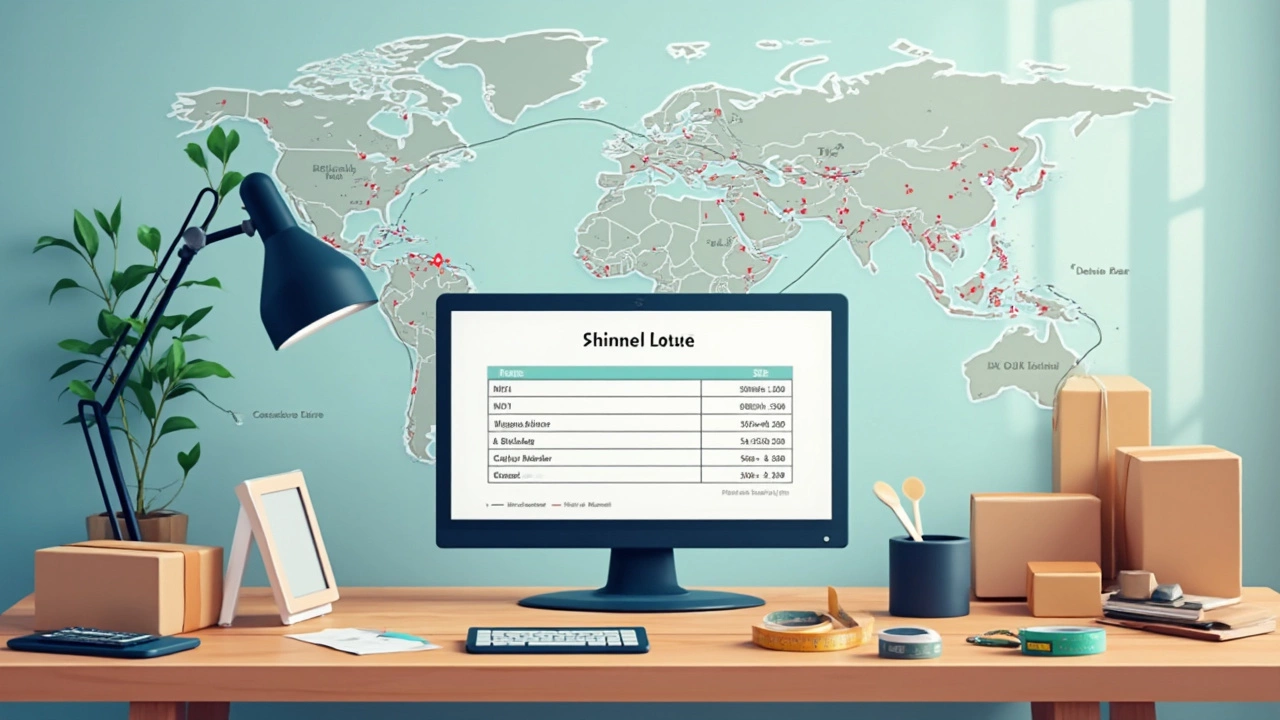Trying to ship a 50 pound box with USPS? Brace yourself. The price isn’t just about weight—it’s also about box size, where it’s going, and the type of service you pick. If you’ve ever been at the post office, sweating over shipping costs that blew past your guess, you’re not alone. The numbers climb fast, especially once your box leaves the country.
Here’s something not everyone realizes: USPS uses a mix of actual weight and what's called “dimensional weight” for larger boxes. That means even if your box is under 50 pounds, if it’s big, you might get hit with extra charges. And with a hard cutoff—USPS won’t ship anything over 70 pounds—the 50-pound box is already pushing the limit, but still manageable with the right planning.
If you’re aiming to send a 50 pound box internationally, expect a lot more sticker shock. The price depends on which country, but also if you pick Priority Mail International, Priority Mail Express International, or flat-rate options—each has its own limits. Knowing these details before you tape that box shut could save you serious cash (and a lot of headache at the counter).
- How USPS Calculates Shipping Costs
- Which USPS Services Allow a 50 Pound Box?
- Real Price Examples for Domestic and International Shipping
- Surprising Fees and Limitations
- Ways to Save on Heavy Shipments
- Common Questions about Large Package Shipping
How USPS Calculates Shipping Costs
USPS sets prices using a mix of weight, box size, service level, and where your package is headed. For a 50 pound box, every single thing makes a difference—especially if that box is heading overseas.
The first thing that matters is weight. USPS rounds up to the next whole pound, so a box weighing 50.2 pounds will be treated as 51 pounds (and rejected, since USPS limits at 70 pounds for most services). So, accuracy matters—always double-check your box before heading out.
But here’s where it gets tricky: size matters just as much. USPS uses “dimensional weight” for larger packages, especially for international shipments and packages over one cubic foot in size. If your box is big and light, you might pay based on its size rather than its weight. But with a 50 pound box, dimensional weight can still kick in if your box is huge.
- USPS measures dimensional weight by multiplying length, width, and height (in inches) and dividing by 166 for international (and by 139 for Priority Mail Express International). If the result is higher than actual weight, you’re charged the higher price.
- Service class plays a big part. Priority Mail Express International costs the most but reaches many countries fast (3–5 days). Priority Mail International is popular for heavier boxes, with slower timing but often much cheaper rates.
- The destination matters. Shipping a 50 pound box to Canada might be close to $180 with Priority Mail International, but sending the same box to Australia could be $250 or more, depending on dimensions.
See how the numbers stack up in this simple table (prices are as of early 2025 and can shift):
| Destination | Service | Est. Cost for 50 lbs | Timeframe |
|---|---|---|---|
| Canada | Priority Mail International | $180 | 6–10 days |
| UK | Priority Mail Express International | $265 | 3–5 days |
| Australia | Priority Mail International | $260 | 6–10 days |
Plus, don't forget: there are surcharges for oversized packages, and customs forms are always required outside the U.S. Get your box measured and weighed accurately before you ship, or you could end up spending more than planned—or worse, be turned away at the counter.
Which USPS Services Allow a 50 Pound Box?
With a 50 pound box, you’re operating close to the USPS maximum weight limit, which is 70 pounds for most services. But not every USPS service handles this kind of load, and some have hidden gotchas when it comes to international shipping.
Here’s what actually works:
- USPS Priority Mail: You can ship boxes up to 70 pounds, so a 50 pounder is fine. This covers both regular and Priority Mail International—but keep in mind, the prices jump big-time for international destinations.
- USPS Retail Ground: Also allows up to 70 pounds, but this service is domestic only. It’s often cheaper, but way slower.
- USPS Priority Mail Express: Same weight cap—70 pounds. Good for when time matters more than cost, both for US and international.
- Parcel Select: This is mostly for businesses or high-volume shippers, but you can get up to 70 pounds here too, for domestic only.
Watch out for flat rate boxes—the largest ones tap out at 20 lbs for international shipments and 70 lbs for domestic, but you need to make sure your box actually fits inside the flat rate dimensions. For a 50 pound box, you’re probably well beyond those dimensions unless you’re shipping something super dense.
Here’s a side-by-side look at allowable weights and extra notes for major USPS shipping options:
| Service | Max Weight | International? | Notes |
|---|---|---|---|
| Priority Mail | 70 lbs | Yes | Custom box sizes. Price goes up with distance/weight. |
| Priority Mail Express | 70 lbs | Yes | Faster delivery, more expensive. |
| Priority Mail Large Flat Rate | 70 lbs (US) 20 lbs (International) |
Yes | Box size must fit, international weight much lower. |
| Retail Ground | 70 lbs | No | Domestic only. Slower delivery, lower cost. |
| Parcel Select | 70 lbs | No | Mainly for high-volume shippers, not at every post office. |
If you’re shipping overseas, always double-check the country’s weight limits, because some destinations have stricter rules than USPS itself. Also, every service gets pricier when your box crosses that 50 pound mark, so compare options before hauling your package in.
Real Price Examples for Domestic and International Shipping
Alright, let’s get into the numbers. To ship a big box, the first question is where it’s headed. USPS prices for a 50 pound box change fast based on distance, service, and even the size of your package. Here’s what you might pay as of early 2025:
| Service | Destination | Estimated Cost (50 lbs) | Delivery Time |
|---|---|---|---|
| Priority Mail | U.S. (Zone 1) | $68 - $74 | 1-2 days |
| Priority Mail | U.S. (Zone 8) | $125 - $145 | 2-4 days |
| Priority Mail Express | U.S. (Zone 1) | $195+ | 1 day |
| Priority Mail International | Canada | $230 - $250 | 6-10 days |
| Priority Mail International | UK/Europe | $285 - $350 | 6-10 days |
| Priority Mail Express International | Australia | $370+ | 3-5 days |
For domestic shipping in the U.S., distance matters a lot. Zones are just USPS lingo for how far your box is traveling. Your costs go way up if you’re shipping coast to coast compared to just a state away.
International prices for a 50 pound box can be jaw-dropping. For example, sending a box from New York to Toronto will cost a lot less than to Sydney, and sometimes international shipping costs more than what’s even inside the box. And yes, you really can pay $300 or more just to ship to Europe or Australia—the weight and size limits of the USPS system don’t cut you much slack after 20 pounds.
Here are some tips to make sense of these numbers:
- USPS Flat Rate services max out at 70 lbs, but their largest "Large Flat Rate Box" only fits about 20-25 lbs worth of denser goods—your 50 lb box likely won’t fit, so you’re paying by weight and size.
- If your box is bulky, you might pay more due to dimensional weight—even if it’s still right at 50 lbs.
- Rates change yearly. Use the official USPS calculator online to get exact prices for your zip code, box size, and destination country before dropping money at the counter.
I tested this with a real shipment for my kid, Quentin: one large, 50 pound box to California from New Jersey cost $131 Priority Mail in 2025, and it was nearly double that for Canada. So yeah, pack smart, double-check your box size, and always compare one or two service options if you don’t want sticker shock.

Surprising Fees and Limitations
Shipping a heavy box with USPS sounds simple until you see the fine print. Most people are surprised by the way fees stack up, especially for international shipments. Here’s what catches shippers off guard the most.
First, the oversized box rule. USPS sets a max combined length and girth of 108 inches for most services. If you go over, your box is a no-go, no matter if it’s under 50 pounds. Sometimes, if you’re close to the max, you’ll get slapped with “dimensional weight pricing,” where they charge as if your box weighs more, based on its size. This rule especially kicks in for Priority Mail and international services.
Then there’s the matter of surcharges. If your box is odd-shaped, rolls, or can’t stack flat, be ready for extra fees. Oversized non-machinable items get hit with a $15 charge (as of early 2025), even for domestic packages. And if you go past 70 pounds, USPS won’t take your parcel at all. For international, not only does each country have a different weight and size requirement, but certain places have even stricter limits—think 44-pound caps for Italy or 66 pounds for Australia.
- Customs paperwork: For any international shipment, you must fill out a customs form, and wrong info slows everything down or gets your box sent back—with no refund for shipping.
- Delivery area surcharges: Not everywhere is treated the same. Remote countries or rural regions sometimes cost more or take weeks longer.
- Insurance limits: USPS will cover up to a certain amount, and maxes depend on the service. Priority Mail International usually includes $200, but that won’t come close if your box has valuable electronics or collectibles.
Last tip—if you’re using any of the flat rate boxes thinking you’ll save a bundle, check the fine print. The largest flat-rate options tap out at under 50 pounds, and if you even hit exactly 50, the counter clerk might make you repack. Always aim for a couple of ounces under the max weight to stay clear of surprise headaches.
Staying sharp about these USPS surprises makes shipping a lot less painful, especially if you do it often.
Ways to Save on Heavy Shipments
Shipping a heavy package like a 50 pound box can be brutal on your wallet, but there are real ways to bring the cost down. It starts with knowing your options and taking a few steps most people skip.
- USPS Flat Rate Boxes: If your 50 pound box can fit inside a Large Flat Rate Box (and it’s less than 70 lbs), you’re in luck. The price is the same no matter how much it weighs, which can save you big bucks for dense stuff. Large Flat Rate is around $24.50 for domestic and about $120 for international.
- Compare Regional Rate Options: USPS has Regional Rate boxes for smaller zones, mostly domestic. If your box isn’t oversized, this is worth checking on their website’s Rate Calculator.
- Use Third-Party Shipping Tools: Websites like Pirate Ship and Shippo sometimes offer commercial USPS rates--a lot cheaper than at the post office counter. It takes a couple extra clicks online but can cut 10%-20% off the price.
- Pay Attention to Dimensions: If your box is bigger than a standard size, it may get hit with dimensional pricing. Keep the box snug to avoid extra fees.
- Print Labels at Home: Printing shipping at home can bring a discount, as online rates are usually a few bucks cheaper per shipment.
Here's a comparison of different USPS services for heavy international shipments:
| Service | Weight Limit | Est. Price to UK (50 lb) | Delivery Time |
|---|---|---|---|
| Priority Mail International | 70 lbs | $345 | 6-10 days |
| Priority Mail Express Intl | 70 lbs | $485 | 3-5 days |
| Large Flat Rate Box Intl | 20 lbs | $120 | 6-10 days |
Don’t forget—sometimes splitting your shipment into two boxes can actually cost less than sending one jumbo box, especially internationally. Always double-check using the USPS shipping calculator online, because prices change all the time, and the smallest adjustment in size or weight can make a big difference. Experiment with combinations to find what works best for your package and budget.
Common Questions about Large Package Shipping
Heavy boxes tend to bring up a lot of the same worries, so let’s break down what folks usually want to know about shipping a big package with USPS.
USPS puts a hard limit on package weight: 70 pounds is the max for most services. If your box weighs 51 pounds or more, there’s no special rate—same pricing rules, just no going above 70 pounds. That said, not every service will actually let you ship something that heavy internationally. Double check service availability before you get in line.
People often ask, “Does the box size matter if it’s under the weight limit?” Yes, it can matter a lot. USPS uses dimensional weight pricing: bigger boxes sometimes cost more, even if they're not super heavy. Priority Mail and Priority Mail Express both use this system if your box is larger than 1 cubic foot. If you can, use the smallest box possible that still fits your stuff snugly. Less wasted space means less wasted money.
Another thing parents like me keep bumping into during holiday season: "How do I know if my box is too big for USPS?" The postal service has size limits—nothing longer than 108 inches (any side), and for international shipments, the combined length and girth (L + 2W + 2H) can’t be more than 108 inches. Miss that mark, and you’ll need to turn to FedEx or UPS instead.
Here’s a quick table showing maximum weight and size rules for some popular USPS options:
| Service | Max Weight | Size Limits |
|---|---|---|
| Priority Mail | 70 lbs | L + 2W + 2H ≤ 108 in |
| Priority Mail Express International | 70 lbs | L + 2W + 2H ≤ 108 in |
| Priority Mail International Large Box | 20 lbs | Box size only (fixed) |
| First-Class Package International | 4 lbs | Varies (very small) |
A few other common questions come up all the time:
- Is insurance included? Priority Mail and Express include some coverage (usually $100-$200), but double check if you need more—especially for pricey items.
- Can you bring your own box? Yes, for weight-based shipping. If you use flat-rate boxes, you must use USPS-branded ones.
- What if the package is a weird shape? Odd shapes are allowed, but if it can’t go on a conveyor belt, you’ll pay an extra “nonmachinable” fee. Smooth rectangular shapes ship the cheapest.
- Do you need to weigh the box at home? It’s best to, or you might get a surprise at the post office. Household scales work if they're accurate enough for heavy stuff. Don’t guess—if it's over 70 pounds, they just won’t ship it.
If you’re mailing something really pricey or fragile, tack on extra insurance and use a box with new, thick cardboard. Heavy boxes need to be packed super tight—no rattling. And remember: you’ll have to fill out a customs form for all international shipments, no matter how big or small.


